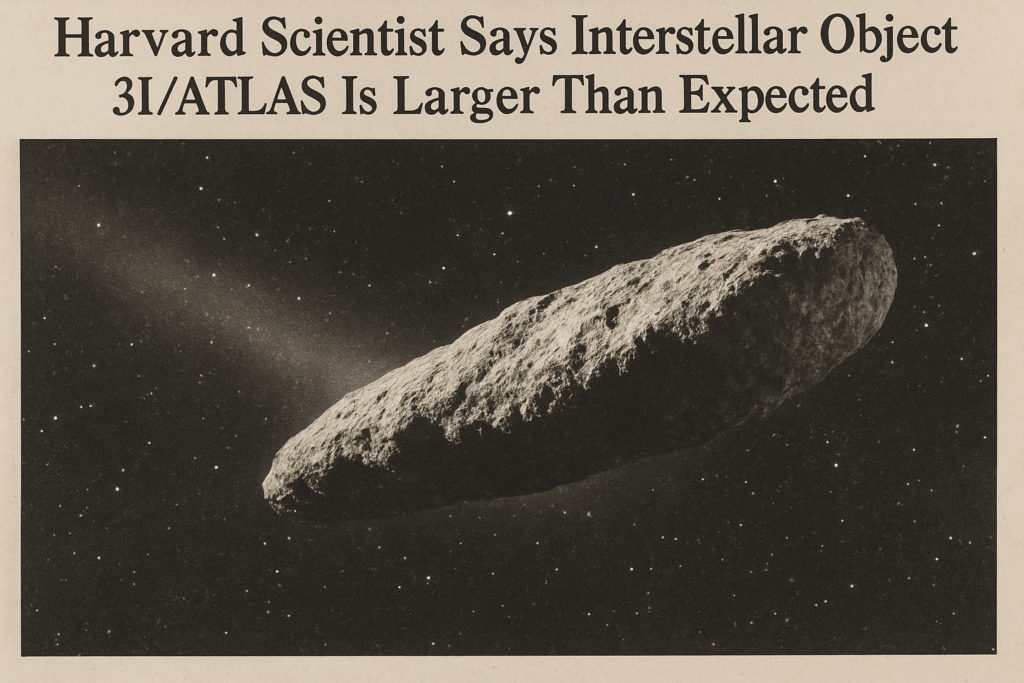BY Harshit September 24, 2025 | Cambridge, Massachusetts | 4:00 AM EDT
The mystery surrounding the interstellar object 3I/Atlas has deepened after a new study suggested it is significantly larger and heavier than astronomers initially believed. Harvard astrophysicist Avi Loeb, working alongside Richard Cloete and Peter Veres, has presented evidence indicating that the object’s nucleus may exceed five kilometers in diameter and weigh more than 33 billion tons.
The findings place 3I/Atlas in a category of its own among interstellar visitors, sparking renewed debate about whether the object is a natural comet or something more unusual.
Discovery and Early Observations
3I/Atlas was first detected on July 1, 2025, and quickly became the subject of worldwide attention. Its sheer size, unorthodox trajectory, and peculiar brightness patterns set it apart from typical comets. While the majority of the scientific community classified it as a comet, Loeb has consistently raised questions about whether its observed properties align with conventional expectations.
Data From 4,000 Observations
The latest analysis reviewed 4,022 observations submitted to the Minor Planet Center between May 15 and September 23. Astronomers with the International Astronomical Union tracked its motion and compared the results with expected gravitational patterns.
Loeb’s team concluded that 3I/Atlas experienced non-gravitational acceleration of less than 15 meters per day squared. That relatively small value suggests the object is far more massive than previously thought. In essence, if it were a lighter body, its acceleration from outgassing would have been much more significant.
The James Webb Space Telescope added further weight to this conclusion. On August 6, JWST captured data on the comet’s mass loss rate and outflow speed, both of which confirmed the nucleus is denser and larger than early models predicted.
The Puzzling Brightness of the Nucleus
Perhaps the most striking feature of 3I/Atlas has been its nucleus. From its discovery, the nucleus has consistently outshone its surrounding features. On July 21, the Hubble Space Telescope captured images revealing a sharp “anti-tail” pointing toward the Sun — a rare formation that persisted for weeks.
Later, on August 27, the Gemini South telescope detected a faint conventional tail, but even then the nucleus remained the dominant point of brightness. For most comets, activity shifts outward, creating bright tails or comas that eclipse the nucleus. 3I/Atlas, by contrast, has displayed a nucleus that seems unnaturally persistent.
This unusual brightness behavior continues to divide astronomers, with some seeing it as a natural, if rare, quirk, and others pointing to the possibility that the object is something more than a comet.
Comparisons With Past Interstellar Visitors
Only two interstellar objects have been confirmed before 3I/Atlas: 1I/‘Oumuamua, discovered in 2017, and 2I/Borisov, discovered in 2019. Both were far smaller. ‘Oumuamua measured about 100 meters across, while Borisov was estimated to be around one kilometer wide.
By contrast, the nucleus of 3I/Atlas may exceed five kilometers in diameter. This scale dwarfs its predecessors and contradicts some theoretical models. As Loeb has pointed out, astronomers should statistically have observed hundreds of smaller interstellar objects before detecting one of this size. That inconsistency, he argues, adds to the puzzle.
Scientific Debate Intensifies
Loeb, who previously argued that ‘Oumuamua may have been an artificial probe, has once again suggested that 3I/Atlas might not be entirely natural. He has emphasized the need to question anomalies rather than dismiss them. Still, the broader astronomical community remains cautious, with most researchers categorizing 3I/Atlas as a comet despite its oddities.
Richard Cloete, a co-author of the new study, acknowledged the unusual aspects but urged restraint. “We need more data to be certain about its composition and behavior. At this stage, the safest classification is still cometary,” he said.
Implications for Astronomy
If 3I/Atlas is indeed a massive, naturally occurring comet, its discovery broadens the spectrum of what scientists understand about interstellar objects. It could indicate that large cometary bodies traverse the galaxy more often than models predict, but have simply gone undetected until now.
If, however, its properties continue to resist conventional explanation, 3I/Atlas could become the centerpiece of a broader scientific debate — one that challenges assumptions about what drifts between the stars.
Looking Ahead
Astronomers will continue to observe 3I/Atlas in the coming months as it makes its journey through the solar system. Instruments ranging from the James Webb Space Telescope to ground-based observatories will track its light curves, measure outgassing rates, and refine calculations of its mass and trajectory.
For now, 3I/Atlas stands as one of the most enigmatic visitors ever detected. Whether it proves to be an unusually massive comet, a statistical outlier, or something that defies current categories, its presence has already expanded scientific imagination.
As Loeb remarked, “When an object doesn’t fit expectations, we have an obligation to ask why. 3I/Atlas is forcing us to do exactly that.”







